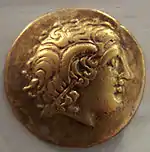Mandubii
The Mandubii (singular masculine: Mandubios, singular feminine: Mandubia) were a small Gallic tribe dwelling near their chief town Alesia, in modern Côte-d'Or, during the Iron Age and the Roman period.
Name
An oppidum Mandubiorum is mentioned by Caesar (mid-1st c. BC),[1] and the tribe is designated as Mandoubíōn (Μανδουβίων) by Strabo (early 1st c. AD).[2][3]
The Gaulish ethnonym Mandubii is generally seen as stemming from the root mandu- ('poney').[4][5] Alternatively, Pierre-Yves Lambert has proposed to compare the name with the Welsh mathru ('trample upon').[6]
Geography
The territory of the Mandubii was located in the Haux-Aixois region, between the settlements of Alesia in the north, Blessey in the east, Braux in the west, and Sombernon in the southeast.[7] During the reign of the Roman emperor Augustus, their small territory was incorporated into the Lingonian territory.[8] In the unstable period following the death of Nero in 68 AD, the Mandubii were excluded from the Lingonian territory and attached to the Aedui.[7]
History
Mandubian ceramics are attested in Villaines-les-Prévôtes by the 2nd century BC. While under the influence of the neighbouring and more powerful Aedui and Lingones, the Mandubii benefited from a relative autonomy (at least economic and cultural) before the Roman conquest.[9]
References
- Caesar. Commentarii de Bello Gallico, 7:68:1.
- Strabo. Geōgraphiká, 4:2:3.
- Falileyev 2010, s.v. Mandubii.
- Evans 1967, pp. 222–223.
- Delamarre 2003, p. 215.
- Lambert 1994, p. 36.
- Barral, Guillaumet & Nouvel 2002, p. 280.
- Barral, Guillaumet & Nouvel 2002, p. 279.
- Barral, Guillaumet & Nouvel 2002, p. 282.
Bibliography
- Barral, Philippe; Guillaumet, Jean-Paul; Nouvel, Pierre (2002). Garcia, D.; Verdin, F. (eds.). "Le territoire des Éduens d'après les dernières découvertes". Territoires celtiques, espaces ethniques et territoire des agglomérations d'Europe occidentale, actes du XXIV° congrès de l'AFEAF, Martigues, 1er - 4 juin 2000. Errance: 271–296.
- Delamarre, Xavier (2003). Dictionnaire de la langue gauloise: Une approche linguistique du vieux-celtique continental. Errance. ISBN 9782877723695.
- Evans, D. Ellis (1967). Gaulish Personal Names: A Study of Some Continental Celtic Formations. Clarendon Press. OCLC 468437906.
- Falileyev, Alexander (2010). Dictionary of Continental Celtic Place-names: A Celtic Companion to the Barrington Atlas of the Greek and Roman World. CMCS. ISBN 978-0955718236.
- Lambert, Pierre-Yves (1994). La langue gauloise: description linguistique, commentaire d'inscriptions choisies. Errance. ISBN 978-2-87772-089-2.
